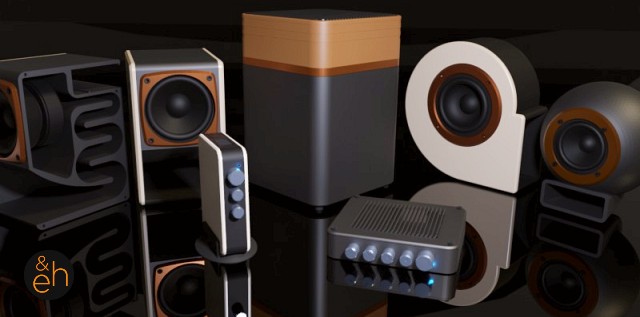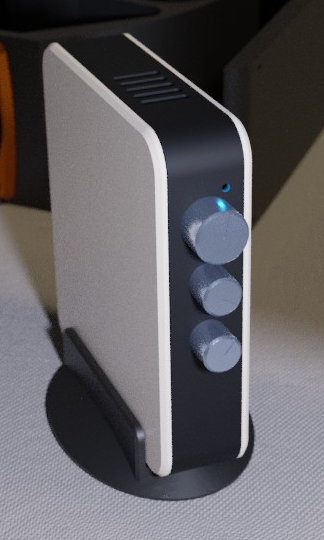
Check out the full set of stereo components (and plenty of other stuff): https://www.thingiverse.com/guppyk2/collections/my-stuff
Here it is. Kissing the frog V3.0.
This is mainly a design (aesthetic) upgrade and includes many suggestions for improvements that came from the community in the last weeks - thanks all! I have always wanted to try squeezing that back horn into something that looks like a nautilus (or somewhat more prosaic, snail) shell.
Once again a complete redesign, even more stylish, super cheap, no soldering, and fully printable (and the main body is still a single print).
Here the differences (as compared to V2.0):
Once again the concept remains the same. It is like kissing the frog. You kiss that 4" loudspeaker and hope it turns into a prince. And it does... (actually it turns into some kind of Nautilus. I guess amphibian to mollusc is easier than amphibian to human - and you don't need to be a princess to achieve that).
The enclosure is for a 4" (10 cm) driver. You can use it as a Bluetooth, active, or passive speaker. There is a box attached to the back for the electronics, which this time is a single BT-amplifier board.
And here is what you will need:
However, basically any combination will do (as long as the driver is 4" or smaller so it fits the enclosure).
 | . | OPTION 2. The BT/amplifier board is optional. You can just as well use them as passive speakers. Just connect to your favorite amplifier. I am currently working on an enclosure to match the speaker's design based on this amplifier: 2x50W TPA3116D2 Bluetooth 5.0 Stereo Amplifier Board. Very happy with this board. It is using the same chip (TPA3116D2) as the amplifier I used in V2.0 but has a much better designed board, no noise, it has treble and bass control, and great sound. Stay tuned if that's what you are looking for. I will post the enclosure as soon as it is completed (expect around early Jan). UPDATE 08Jan21: The amplifier is now online: https://www.thingiverse.com/thing:4713469 |
PRINTING. This should be a simple print. No support or plate adhesion needed. Print in PLA (or ABS, PETG...) at 0.28 mm resolution and (around) 15% infill.
The front panel can theoretically be cut from 6-8 mm plywood (however, this time I printed the entire enclosure). Glue the front panel to the body. Attach the speaker ring and speaker with M3 screws. The feet (I print these in TPU) are optional (particularly if you are planning to use the wall mount).
WIRING. This time wiring should be much simpler and requires no soldering (even when using the BT-amplifier). I have included a wiring diagram. You won't need any soldering this time but basic electronic skills are helpful. Make sure that you know what you are doing (particularly dealing with high voltage). All at your own risk and no warranty whatsoever! Remember, the BT-amplifier will give you a stereo output (i.e. is intended for 2 speakers). If you use only a single speaker you need to send a mono BT signal (most mobile phones will support this) to the receiver or you will get half stereo (i.e. only left or right channel, which is not the same as mono).
ASSEMBLY. Print one peace each of the main body, the front cover, the speaker ring, and the little BT/amp enclosure plus 4 pieces of the feet (the last 2 being optional). Mount the speaker to the inside of the front panel and speaker ring with M3 screws/nuts. Lead the speaker cable through the little hole in the center out to the back. Add some damping (e.g. foam) to the back of the main chamber behind the speaker. Glue the front panel to the main body (use course sandpaper to roughen the connecting surfaces before gluing). Attach the speaker cable(s) to the BT/amp board, put it upside down into the little box and mount the box to the back of the main body with 4 M3 (approx. 25 mm) screws. Connect to your power adapter, turn on Bluetooth on your phone, connect, ENJOY!
THEORY. Here a little theory for all those who missed V2.0: What is a back loaded horn speaker? Think of it as a reversed megaphone or gramophone. A (front) horn loudspeaker uses an acoustic horn to increase the overall efficiency of the driving element (i.e. the sound coming out at the front). A back loaded horn speaker does pretty much the same. However, here the horn is mounted at the back of the loudspeaker. So you get the direct output from the front of the driver PLUS the one from the horn at the back. Which frequencies are amplified and how well depends on the air chamber, throat (the narrow part), and on the length, design, and diameter of the horn. Particularly with small (and cheap) drivers this can very much improve the sound quality.
UPDATE 06Jan21: Upon request I have just added an adapter to use 3.3" (like FRS8M) drivers in V3.0.
I REALLY HOPE YOU LIKE IT AND IF YOU LIKE IT, PLEASE LIKE IT! Thanks!
Enjoy!
| Speaker_Backhorn_V3_Adapter_FRS8M.stl | 248.9KB | |
| Speaker_Backhorn_V3_Body.stl | 1.2MB | |
| Speaker_Backhorn_V3_BTAmp.stl | 555.7KB | |
| Speaker_Backhorn_V3_Feet.stl | 13.8KB | |
| Speaker_Backhorn_V3_Front.stl | 1.2MB | |
| Speaker_Backhorn_V3_Ring.stl | 271.6KB |